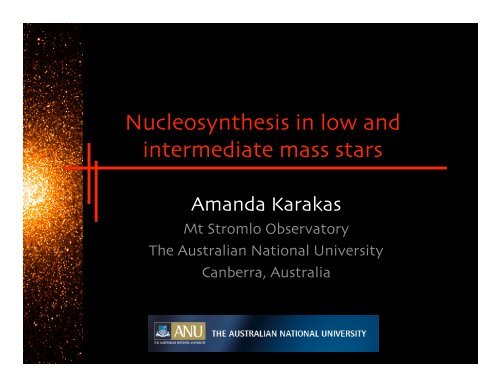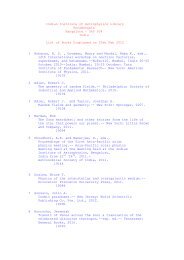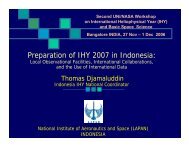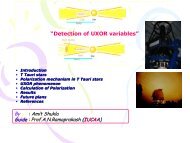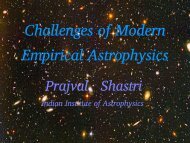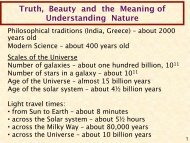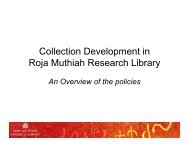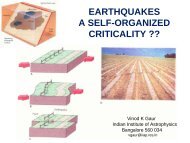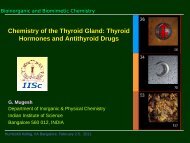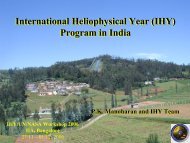Nucleosynthesis in low and intermediate mass stars
Nucleosynthesis in low and intermediate mass stars
Nucleosynthesis in low and intermediate mass stars
Create successful ePaper yourself
Turn your PDF publications into a flip-book with our unique Google optimized e-Paper software.
<strong>Nucleosynthesis</strong> <strong>in</strong> <strong>low</strong> <strong>and</strong><br />
<strong>in</strong>termediate <strong>mass</strong> <strong>stars</strong><br />
Am<strong>and</strong>a Karakas<br />
Mt Stromlo Observatory<br />
The Australian National University<br />
Canberra, Australia
Introduction<br />
• Stars with <strong>mass</strong>es ~0.8 to 8M sun will become asymptotic giant<br />
branch (AGB) <strong>stars</strong> near the end of their life<br />
• It is estimated that ~50% of the gas <strong>and</strong> dust <strong>in</strong> the Galaxy<br />
comes from red giants <strong>in</strong>clud<strong>in</strong>g AGB <strong>stars</strong><br />
• They are important factories for produc<strong>in</strong>g many elements<br />
(e.g. carbon, nitrogen, 19 F, elements heavier than Fe)<br />
• Models of AGB <strong>stars</strong> can help expla<strong>in</strong> the unusual composition<br />
of very metal-poor <strong>stars</strong>, <strong>and</strong> of pre-solar gra<strong>in</strong>s<br />
• Do <strong>mass</strong>ive AGB <strong>stars</strong> play a role <strong>in</strong> the globular cluster<br />
abundance anomalies?<br />
• In this talk I will focus on a couple of examples that test our<br />
knowledge of AGB <strong>stars</strong> <strong>and</strong> stellar nucleosynthesis
Basic Stellar Evolution<br />
Z = 0.02 or [Fe/H] = 0.0 , metallicity refers to both Z,<br />
total metals, or [Fe/H] = log 10 (Fe/H) star - log 10 (Fe/H) sun<br />
Ma<strong>in</strong> sequence:<br />
H to Helium<br />
τ ~ 10 10 yrs for 1<br />
~ 10 8 yrs for 5<br />
Red Giant Branch:<br />
core contracts<br />
outer layers exp<strong>and</strong><br />
E-AGB phase:<br />
a-er core He-burn<strong>in</strong>g<br />
star becomes a red giant<br />
for the second time
Gett<strong>in</strong>g processed matter out<br />
• For <strong>mass</strong>ive <strong>stars</strong>, explosions end the star’s life <strong>and</strong><br />
releases matter <strong>in</strong>to the <strong>in</strong>terstellar medium<br />
• For <strong>low</strong>-<strong>mass</strong> <strong>stars</strong>, there are no explosions<br />
• Instead, <strong>mass</strong> loss s<strong>low</strong>ly removes the envelope<br />
• Mix<strong>in</strong>g between the core <strong>and</strong> the envelope takes<br />
place to change the surface composition<br />
• There are st<strong>and</strong>ard mix<strong>in</strong>g events:<br />
– First dredge-up: hydrogen-fusion processed material<br />
– Second dredge-up: H-burn<strong>in</strong>g<br />
– Third dredge-up: Products of He-fusion<br />
AGB{ – Hot bottom burn<strong>in</strong>g: H-burn<strong>in</strong>g
Where mix<strong>in</strong>g takes place<br />
HBB, TDU<br />
SDU<br />
FDU
Asymptotic Giant Branch <strong>stars</strong><br />
H-rich envelope<br />
Mass scale:<br />
Total <strong>mass</strong> = 3Msun,<br />
Core <strong>mass</strong> = 0.6Msun<br />
Envelope <strong>mass</strong> = 2.4Msun<br />
Radial scale:<br />
If we scale the core to the size of a<br />
marble (few cms) then to reach the<br />
outer layers we have to travel ~<br />
500 metres!<br />
H-exhausted core
Example: 3Msun, Z = 0.02
Zoom <strong>in</strong> on first few thermal pulses<br />
Time is scaled: (t-4.23 x 10 8 /1x 10 5 )<br />
White = radiated lum<strong>in</strong>osity<br />
Green = he-burn<strong>in</strong>g lum<strong>in</strong>osity, <strong>and</strong> Red = H-burn<strong>in</strong>g lum<strong>in</strong>osity
AGB lifecycle <strong>in</strong> more detail<br />
Deep convective<br />
envelope<br />
H-burn<strong>in</strong>g shell<br />
He-rich <strong>in</strong>tershell<br />
He-burn<strong>in</strong>g shell<br />
C-O core
AGB lifecycle <strong>in</strong> more detail<br />
Deep convective<br />
envelope<br />
H-burn<strong>in</strong>g shell<br />
He-rich <strong>in</strong>tershell<br />
He-burn<strong>in</strong>g shell<br />
C-O core
AGB lifecycle <strong>in</strong> more detail<br />
Deep convective<br />
envelope<br />
H-burn<strong>in</strong>g shell<br />
He-rich <strong>in</strong>tershell<br />
He-burn<strong>in</strong>g shell<br />
C-O core
AGB lifecycle <strong>in</strong> more detail<br />
Deep convective<br />
envelope<br />
H-burn<strong>in</strong>g shell<br />
He-rich <strong>in</strong>tershell<br />
He-burn<strong>in</strong>g shell<br />
C-O core
AGB lifecycle <strong>in</strong> more detail<br />
Deep convective<br />
envelope<br />
H-burn<strong>in</strong>g shell<br />
He-rich <strong>in</strong>tershell<br />
He-burn<strong>in</strong>g shell<br />
C-O core
AGB lifecycle <strong>in</strong> more detail<br />
Deep convective<br />
envelope<br />
H-burn<strong>in</strong>g shell<br />
He-rich <strong>in</strong>tershell<br />
He-burn<strong>in</strong>g shell<br />
C-O core
The AGB Evolution Cycle<br />
1. On phase: He-shell burns brightly, produc<strong>in</strong>g up to 100<br />
million L sun , drives a convection zone <strong>in</strong> the He-rich <strong>in</strong>tershell<br />
<strong>and</strong> lasts for ~ 100 years<br />
2. Power-down: He-shell dies down, energy released by flash<br />
drives expansion which ext<strong>in</strong>guishes the H-shell<br />
3. Third dredge-up: convective envelope moves <strong>in</strong>ward <strong>in</strong>to<br />
regions mixed by flash-driven convection. Mixes partially Heburnt<br />
material to surface.<br />
4. Interpulse: star contracts <strong>and</strong> H-shell is re-ignited, provides<br />
most of the surface lum<strong>in</strong>osity for the next 10 4 to 10 5 years<br />
Pulse (He-burn<strong>in</strong>g) TDU (mix<strong>in</strong>g) Interpulse<br />
Few ~10 2 yrs ~10 2 years ~10 4-5 yrs
<strong>Nucleosynthesis</strong>: He-burn<strong>in</strong>g<br />
• Ma<strong>in</strong> energy-generat<strong>in</strong>g reactions:<br />
– 3α process: 3 4 He 12 C<br />
– 12 C(α,γ) 16 O – relatively unimportant dur<strong>in</strong>g<br />
thermal pulses<br />
• Other reactions:<br />
– 14 N captures 2 α particles to make 22 Ne<br />
– 22 Ne can capture an α particle to produce<br />
25,26<br />
Mg. Only occurs when T > 300 million K<br />
– 19 F can be produced through complex series of<br />
reactions <strong>in</strong>volv<strong>in</strong>g both H, He-burn<strong>in</strong>g <strong>and</strong><br />
neutron-capture nucleosynthesis
Mak<strong>in</strong>g Carbon Stars!<br />
• Thermal pulses <strong>and</strong> dredge-up can occur many<br />
times dur<strong>in</strong>g the AGB<br />
• Dredge up mixes 12 C from the He-shell to the<br />
surface, <strong>in</strong>creas<strong>in</strong>g the C/O ratio to > 1<br />
• Can expla<strong>in</strong> the transition from M-type star (with<br />
C/O 1)<br />
• Along with carbon, the third dredge-up mixes<br />
elements created by the s<strong>low</strong>-neutron capture<br />
process (s-process) <strong>in</strong>to the envelope<br />
• Fluor<strong>in</strong>e is produced <strong>in</strong> the <strong>in</strong>tershell <strong>and</strong> mixed<br />
to the surface by the TDU (Jorissen et al. 1992)
This is how we make carbon <strong>stars</strong>!
And it’s easier at <strong>low</strong>er metallicity<br />
M = 3, Z = 0.004, [Fe/H] ~ - 0.7
Hot bottom burn<strong>in</strong>g<br />
• In <strong>mass</strong>ive (M > 3Msun) AGB <strong>stars</strong> the base of the convective<br />
envelope can dip <strong>in</strong>to the H-shell<br />
• Typical temperatures between ~50 to 100 million K<br />
• Burn<strong>in</strong>g region is th<strong>in</strong> <strong>in</strong> <strong>mass</strong> (10 -4 Msun) but efficient mix<strong>in</strong>g<br />
means that entire envelope is exposed to hot region at least<br />
1000 times per <strong>in</strong>terpulse!<br />
• Envelope burn<strong>in</strong>g was orig<strong>in</strong>ally proposed to expla<strong>in</strong><br />
existence of lum<strong>in</strong>ous O-rich AGB <strong>stars</strong> <strong>in</strong> the LMC (Wood,<br />
Bessel & Fox 1983)<br />
• Many of these <strong>stars</strong> also rich <strong>in</strong> lithium <strong>and</strong> s-process<br />
elements (Smith & Lambert 1989)<br />
• Dredge-up can still occurs but CNO cycl<strong>in</strong>g at the base of the<br />
envelope prevents the formation of a C-rich atmosphere
Dredge-up still occurs
But the base of the envelope is hot!<br />
6.5M sun , Z =Z solar : Peak temperature ~ 90 x 10 6 K
Surface abundance evolution<br />
The 13 C content <strong>in</strong>creases, due to the process<strong>in</strong>g of 12 C <strong>in</strong>to 12 C. In extreme cases,<br />
when the entire envelope can be processed many time between pulses, HBB can<br />
produce the equilibrium ratio of 12 C/ 13 C of about 3.5. A consequence of this burn<strong>in</strong>g<br />
is the copious production of primary 14 N.
Production of sodium<br />
Surface abundance evolution dur<strong>in</strong>g the AGB phase<br />
sodium production<br />
Production of 25,26 Mg
Production of Li <strong>and</strong> destruction of F<br />
F production <strong>and</strong> destruction!<br />
Short-lived Li production phase<br />
as a result of HBB
Model uncerta<strong>in</strong>ties<br />
• Mass loss: model calculations use simple parameterized<br />
formulae which are supposed to be an average of what is<br />
observed. What about <strong>mass</strong> loss for very <strong>low</strong> Z models?!<br />
• Convection: 1D models mostly use mix<strong>in</strong>g-length theory. Also<br />
numerical problem of treat<strong>in</strong>g convective boundaries<br />
• Extra-mix<strong>in</strong>g? When <strong>and</strong> where to apply! What are the physical<br />
processes that produce it (e.g. rotation, overshoot)? Multidimensional<br />
modell<strong>in</strong>g is required!<br />
• Reaction rates: improvements have been made but large<br />
uncerta<strong>in</strong>ties rema<strong>in</strong> for many important reactions e.g.<br />
22<br />
Ne(a,n) 25 Mg<br />
• Low-temperature molecular opacities: AGB <strong>stars</strong> have cool<br />
enough outer layers to dem<strong>and</strong> a proper treatment
The s<strong>low</strong>-neutron capture process<br />
The s process is responsible for the<br />
production of about half the<br />
abundances of elements heavier<br />
than iron <strong>in</strong> the Galaxy.<br />
s-process peaks<br />
Dur<strong>in</strong>g the s process:<br />
N n ~ 10 7 n/cm 3<br />
t(n,g) >> t b
Chart of the Nuclides<br />
The further a nucleus is from the valley of nuclear stability, the more<br />
unstable it is to β ± decay i.e. the shorter is its half-life<br />
From Frank Timmes website
The s-process path<br />
p-process nuclei - proton rich!<br />
S-only isotope<br />
The unstable Tc is observed <strong>in</strong> <strong>stars</strong>!<br />
r-process isotope<br />
s-process branch<strong>in</strong>g po<strong>in</strong>t
Time evolution of their structure.<br />
Where <strong>in</strong> AGB <strong>stars</strong>?<br />
4<br />
He, 12 C, 22 Ne, s-process elements: Zr, Ba, ...
Time evolution of their structure.<br />
Where <strong>in</strong> AGB <strong>stars</strong>?<br />
4<br />
He, 12 C, 22 Ne, s-process elements: Zr, Ba, ...<br />
At the<br />
stellar<br />
surface:<br />
C>O, s-<br />
process<br />
enhance<br />
ments
Theoretical models: the neutron sources<br />
proton<br />
diffusion<br />
13<br />
C(α,n) 16 O<br />
Interpulse phase (t ~ 10 4 years)
Theoretical models: the neutron sources<br />
proton<br />
diffusion<br />
13<br />
C(α,n) 16 O<br />
22<br />
Ne(α,n) 25 Mg<br />
Interpulse phase (t ~ 10 4 years)
Theoretical models: the neutron sources<br />
Low <strong>mass</strong> AGBs<br />
Intermediate <strong>mass</strong> AGBs<br />
Lower temperature ~4.5 M Higher temperature<br />
Larger <strong>in</strong>tershell <strong>mass</strong><br />
Smaller <strong>in</strong>tershell <strong>mass</strong><br />
proton<br />
diffusion<br />
13<br />
C(α,n) 16 O<br />
22<br />
Ne(α,n) 25 Mg<br />
Interpulse phase (t ~ 10 4 years)
Inclusion of a 13 C pocket<br />
• St<strong>and</strong>ard <strong>low</strong>-<strong>mass</strong> AGB models do not produce<br />
enough s-process elements to match observations<br />
of AGB <strong>stars</strong><br />
• That is because there is not enough 13 C <strong>in</strong> the He<strong>in</strong>tershell<br />
to activate the 13 C(α,n) 16 O reaction<br />
• So we need to artificially add <strong>in</strong> some 13 C<br />
• This is not great, but the best we can do <strong>in</strong> 1D<br />
• The mix<strong>in</strong>g mechanism <strong>and</strong> the extent <strong>in</strong> <strong>mass</strong> of<br />
the pocket are unknown<br />
• see Herwig (2005, ARAA) for more discussions<br />
about 13 C pockets <strong>and</strong> 3D efforts be<strong>in</strong>g made to<br />
underst<strong>and</strong> how they form
Theoretical models<br />
Typical neutron<br />
density profile <strong>in</strong><br />
time:<br />
Low <strong>mass</strong><br />
Intermediate <strong>mass</strong><br />
Neutron source<br />
13<br />
C(a,n) 16 O<br />
22<br />
Ne(a,n) 25 Mg<br />
Maximum<br />
neutron density<br />
Timescale<br />
10 8 n/cm 3<br />
10,000 yr<br />
10 13 n/cm 3<br />
10 yr<br />
Neutron exposure<br />
0.3 mbarn -1 0.02 mbarn -1<br />
(at solar metallicity)
Neutron density <strong>in</strong>dicators<br />
At high neutron densities, two branch<strong>in</strong>g po<strong>in</strong>ts open that al<strong>low</strong><br />
rubidium to be produced. At N n =5 x 10 8 n/cm 3 ~80% of the flux goes<br />
through 85 Kr, <strong>and</strong> the branch<strong>in</strong>g at 86 Rb opens to make 87 Rb<br />
1.<br />
85<br />
Rb has a high σ = 240 mb (30 keV)<br />
2. 87 Rb is magic, has a <strong>low</strong> σ = 15 mb (30 keV)<br />
Rb <strong>in</strong> AGB <strong>stars</strong> <strong>in</strong> an <strong>in</strong>dicator of the neutron density!<br />
86<br />
Kr, 87 Rb, <strong>and</strong> 88 Sr are<br />
all magic, with <strong>low</strong> neutron<br />
capture cross sections<br />
In <strong>low</strong>-<strong>mass</strong> <strong>stars</strong>: 88 Sr produced<br />
In <strong>mass</strong>ive AGB: 87 Rb
Rubidium enhancements <strong>in</strong> AGB <strong>stars</strong><br />
Max. production factor ~ 100!<br />
[Rb/Fe]<br />
Increas<strong>in</strong>g stellar <strong>mass</strong><br />
From D. A. Garcia-Hern<strong>and</strong>ez et al. (2006, Science)
Comparison to observations: Rb<br />
Carbon <strong>stars</strong> from Abia et al.<br />
(2001): <strong>low</strong> <strong>mass</strong> AGBs<br />
OH <strong>stars</strong> from Garcia-Hern<strong>and</strong>ez et<br />
al. (2006): <strong>in</strong>termediate <strong>mass</strong> AGBs<br />
Stellar model of 1.5, 5 M <strong>and</strong><br />
Z (FRANEC + Tor<strong>in</strong>o)<br />
Stellar model of 3 M <strong>and</strong> Z <br />
(MONSSTAR + Monash).
Comparison to observations: Rb<br />
Carbon <strong>stars</strong> from Abia et al.<br />
(2001): <strong>low</strong> <strong>mass</strong> AGBs<br />
OH <strong>stars</strong> from Garcia-Hern<strong>and</strong>ez et<br />
al. (2006): <strong>in</strong>termediate <strong>mass</strong> AGBs<br />
Stellar model of 1.5, 5 M <strong>and</strong><br />
Z (FRANEC + Tor<strong>in</strong>o)<br />
Stellar model of 3 M <strong>and</strong> Z <br />
(MONSSTAR + Monash).
Comparison to observations: Rb<br />
Carbon <strong>stars</strong> from Abia et al.<br />
(2001): <strong>low</strong> <strong>mass</strong> AGBs<br />
OH <strong>stars</strong> from Garcia-Hern<strong>and</strong>ez et<br />
al. (2006): <strong>in</strong>termediate <strong>mass</strong> AGBs<br />
Stellar model of 1.5, 5 M <strong>and</strong><br />
Z (FRANEC + Tor<strong>in</strong>o)<br />
Stellar model of 3 M <strong>and</strong> Z <br />
(MONSSTAR + Monash).<br />
Stellar model of 6.5 M <strong>and</strong> Z <br />
(MONSSTAR + Monash).<br />
Stellar model of 5 M <strong>and</strong> Z <br />
(MONSSTAR + Monash).
We also produce Zr…
How do AGB <strong>stars</strong> make F?<br />
• The reaction cha<strong>in</strong>: 18 O(p, α) 15 N(α, γ) 19 F(α, p) 22 Ne<br />
• Fluor<strong>in</strong>e production takes place <strong>in</strong> the He<strong>in</strong>tershell<br />
region: He-rich, H poor<br />
• There are almost no protons, <strong>and</strong> little 15 N<br />
• These are created by other reactions <strong>in</strong>clud<strong>in</strong>g:<br />
– 13 C(α, n) 16 O - produces free neutrons<br />
– 14 N(n, p) 14 C - produces free protons<br />
– 18 F(α, p) 21 Ne - alternative proton production<br />
– 14 N(α, γ) 18 F(β + ) 18 O - ma<strong>in</strong> reaction to produce 18 O<br />
– 14 C(α, γ) 18 O - alternative reaction<br />
– 18 O(α, γ) 22 Ne - ma<strong>in</strong> 18 O destruction reaction<br />
– 15 N(p, α) 12 C - destroys 15 N
Fluor<strong>in</strong>e production<br />
Results for a 3Msun model:<br />
Composition profile show<strong>in</strong>g <strong>in</strong>tershell<br />
region just a-er last TP. TDU will mix<br />
the 19 F created by the pulse <strong>in</strong>to the<br />
envelope<br />
C/O<br />
Abundances from Jorissen et al.<br />
(1992) compared to model results<br />
⊗ - shows SC <strong>stars</strong>, with C/O = 1.0
The 18 F(a,p) 21 Ne reaction<br />
• Lee et al. (2008) recently performed experiments<br />
to obta<strong>in</strong> this reaction rate for the first time<br />
• Up until 2006, only theoretical rate was available<br />
• This experimental evaluation, when consider<strong>in</strong>g its<br />
associated uncerta<strong>in</strong>ties, presented significant<br />
differences compared to the theoretical rate at T ≈<br />
300 million K<br />
• Us<strong>in</strong>g the upper limit of this rate, we f<strong>in</strong>d<br />
<strong>in</strong>creases <strong>in</strong> the production of 19 F <strong>and</strong> 21 Ne<br />
• How does this come about? Through the extra<br />
protons released by this (a,p) reaction<br />
• Further experimental results needed to test the<br />
validity of the upper limit
[F/O] versus C/O ratio<br />
With upper limit<br />
Recommended rate<br />
Karakas et al. (2008)<br />
Increas<strong>in</strong>g C/O ratio
Ne isotopic ratios<br />
Previous models<br />
Pre-solar gra<strong>in</strong> data<br />
With 18 F(a,p) rate, we<br />
can move horizontally<br />
Karakas et al. (2008)
Fluor<strong>in</strong>e <strong>in</strong> C-rich metal-poor <strong>stars</strong><br />
• The fluor<strong>in</strong>e abundance of the carbon-enhanced metal-poor<br />
star HE 1305+0132 is [F/Fe] = 2.90 (Schuler et al. 2007)<br />
• The iron abundance is [Fe/H] = -2.5, mak<strong>in</strong>g HE 1305+0132<br />
the most Fe-deficient star, by more than an order of<br />
magnitude, for which the abundance of fluor<strong>in</strong>e has been<br />
measured<br />
• Schuler et al. concluded that the atmosphere of HE<br />
1305+0132 was polluted via <strong>mass</strong> transfer by a primary<br />
companion dur<strong>in</strong>g its AGB phase<br />
• Lugaro et al. (2008) estimate that AGB models of 2Msun, Z<br />
= 0.0001 can expla<strong>in</strong> the composition of HE 1305<br />
• Al<strong>low</strong><strong>in</strong>g for 3 to 11% of the AGB matter to be accreted by a<br />
companion<br />
• We also predict that most CEMP <strong>stars</strong> should also be rich <strong>in</strong><br />
fluor<strong>in</strong>e, s<strong>in</strong>ce <strong>mass</strong>ive rotat<strong>in</strong>g <strong>stars</strong> of <strong>low</strong> Z do not<br />
produce F
Fluor<strong>in</strong>e <strong>in</strong> HE 1305<br />
Note that HE 1305 has an<br />
Fe abundance ~2.5 orders<br />
of magnitude smaller than<br />
the MS/S/C <strong>stars</strong> <strong>in</strong> this<br />
sample<br />
Most MS/S/C <strong>stars</strong> are disk<br />
<strong>stars</strong> with near solar Z<br />
Logarithmic abundances of 19 F versus 12 C.<br />
The abundances of HE 1305+0132 are marked<br />
by the magenta box with error bars.<br />
From Schuler et al. (2007).
Model results: F, C+N abundances<br />
The grey area is the region<br />
where the F, <strong>and</strong> C+N<br />
abundances from the AGB<br />
companion should be to<br />
match the observed<br />
abundances, a-er dilution<br />
The darker grey is the area<br />
covered by our models<br />
Models: [Fe/H] = -2.3, scaled<br />
solar <strong>in</strong>itial composition<br />
From Lugaro et al. (2008, A&A Letters, <strong>in</strong> press)
Summary<br />
• All <strong>stars</strong> <strong>in</strong> the <strong>mass</strong> range 0.8 to ~8 Msun will<br />
pass through the AGB phase<br />
• AGB <strong>stars</strong> make an important contribution to<br />
the chemical evolution of galaxies<br />
• Important factories for C, N, F, <strong>and</strong> s-process<br />
elements<br />
• Model uncerta<strong>in</strong>ties (e.g. convection, <strong>mass</strong> loss,<br />
nuclear reaction rates) still problematic<br />
• Necessary to compare the models to the<br />
observations<br />
• Abundances from carbon enhanced metal-poor<br />
<strong>stars</strong> provide an <strong>in</strong>terest<strong>in</strong>g set of <strong>stars</strong> for<br />
comparison!
Fluor<strong>in</strong>e <strong>in</strong> the <strong>in</strong>tershell<br />
Fluor<strong>in</strong>e <strong>in</strong>tershell abundance reach a maximum (150 to 290<br />
times solar) for <strong>stars</strong> between 2 <strong>and</strong> 3.5Msun<br />
L<strong>in</strong>es from F v <strong>and</strong> F vi have been discovered <strong>in</strong> FUSE spectra<br />
of several PG1159 <strong>stars</strong> (Werner et al. 2005).<br />
Abundance rang<strong>in</strong>g from solar to 250 times solar


